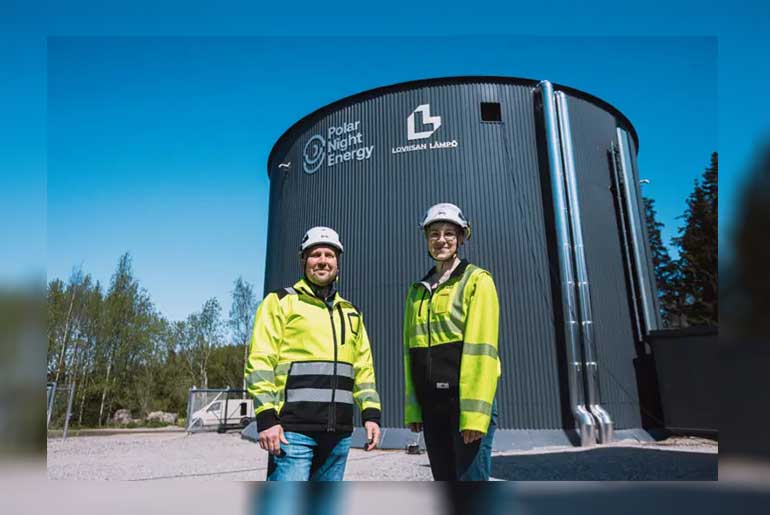Polar Night Energy has built an industrial-scale sand battery in Pornainen for Loviisan Lämpö’s district heating network. The new Sand Battery delivers 1 MW of thermal power and offers a storage capacity of 100 MWh, making it ten times larger than the Sand Battery launched in Kankaanpää in 2022.
“The Sand Battery means a lot to Loviisan Lämpö. It allows us to drastically reduce our emissions and improve the reliability of heat production.”
– Mikko Paajanen, CEO of Loviisan Lämpö.
The Sand Battery is expected to reduce annual CO₂-equivalent emissions from the local heating network by around 160 tons, cutting climate emissions in Pornainen’s district heating by nearly 70 percent.
“Our goal is to be climate neutral by 2035, and the sand battery is a major step toward that.”
– Mikko Paajanen, CEO of Loviisan Lämpö.
With the launch of the Sand Battery, the use of oil in the Pornainen’s heating network will be completely phased out, and the consumption of wood chips will decrease by approximately 60 percent. The existing biomass boiler will continue to serve as a backup and will support the sand battery during peak demand periods.
Developed by Polar Night Energy, the Sand Battery is a high-temperature thermal energy storage system that stores clean and affordable electricity as heat in sand or similar solid materials. It can be used to produce heat for both district heating networks and a wide range of industrial processes.
Energy storage plays a vital role in the energy transition, as the share of wind and solar power in the electricity grid increases and combustion-based energy production is phased down.
“Combustion is not a sustainable option for the climate or the environment. This project is a powerful example that effective solutions for mitigating climate change do exist. Loviisan Lämpö is a great example of a company bold enough to invest in new technologies.”
– Liisa Naskali, Chief Operating Officer of Polar Night Energy.
Polar Night Energy acted as the main contractor for the project and delivered the Sand Battery as a turnkey solution to Loviisan Lämpö. The construction took about a year and involved around 40 subcontractors and over 100 workers.
“Our project team collaborated excellently with the designers, the client, and subcontractors. This is a solid foundation for scaling sand battery technology to even larger capacities and across new industrial sectors.”
– Liisa Naskali, Chief Operating Officer of Polar Night Energy.
The Sand Battery stands about 13 meters tall and 15 meters wide, and it uses approximately 2,000 tons of crushed soapstone as its thermal storage medium. In summer, the Sand Battery can cover almost a month’s heat demand in Pornainen, and in winter, close to a week. The project received energy aid for new technology from Business Finland.
The Sand Battery Balances the Power Grid and Advances the Circular Economy
Driving the circular economy and the energy transition requires concrete action and cross-sector collaboration. The Pornainen Sand Battery project brings together a range of companies and organizations from various industries.
Loviisan Lämpö is owned by CapMan Infra, a fund managed by the private equity firm CapMan, which aims to be the most responsible investor in the Nordics.
“The Sand Battery investment aligns closely with our sustainability goals. From an investor’s perspective, this technology holds tremendous potential: it can participate in electricity reserve markets, reduce dependency on single energy sources in heat production, and serve as a great example of sector integration between electricity and heat.”
– Sauli Antila, Investment Director at CapMan Infra.
A key part of the Sand Battery’s profitability lies in optimizing its operation according to electricity prices and Finland’s grid operator Fingrid’s reserve markets. In doing so, the Sand Battery also supports power grid stability, an essential enabler of the rapid growth of wind and solar energy. Thanks to its large storage capacity, the system allows electricity usage to be optimized over several days or even weeks. The optimization of the Pornainen Sand Battery is handled by Elisa, a Finnish telecommunications and digital software services company.
“Elisa has strong expertise in energy storage optimization and operating in the reserve markets. Our AI-driven solution automatically identifies the most economically viable moments to charge or discharge the Sand Battery. This brings Loviisan Lämpö significant savings and revenue, making the Sand Battery a truly profitable investment.”
– Jukka-Pekka Salmenkaita, Vice President of AI and Special Projects at Elisa Industriq.
The thermal storage medium used in sand batteries can include side streams from manufacturing or mining industries, meaning there’s often no need to extract virgin materials.
In the case of Loviisan Lämpö’s Sand Battery, the medium is crushed soapstone, a by-product from the production of Tulikivi’s heat-retaining fireplaces. The sand battery holds 2,000 tons of this material, roughly equivalent to the weight of a thousand soapstone fireplaces.
“Finland aims to become a carbon-neutral circular economy by 2035. To reach this, we need new cross-sectoral solutions to use resources more efficiently and turn the circular economy into practical reality across more industries.”
– Heikki Vauhkonen, CEO of Tulikivi.
The municipality of Pornainen has supported the project from the beginning. A large portion of the town’s own buildings, including the municipal school, town hall, and library, are connected to the district heating network.
“This project has gone very smoothly. Pornainen wants to be a front-runner in sustainable energy solutions, and we welcome all innovations that support that goal. One of the key targets in our municipal strategy is carbon neutrality, and the sand battery plays an important role in achieving it.”
– Antti Kuusela, Mayor of Pornainen.
Polar Night Energy is currently in active discussions with both Finnish and international partners about new Sand Battery projects. Earlier this spring, the company announced a pilot in Valkeakoski to explore the conversion of stored thermal energy back into electricity.



